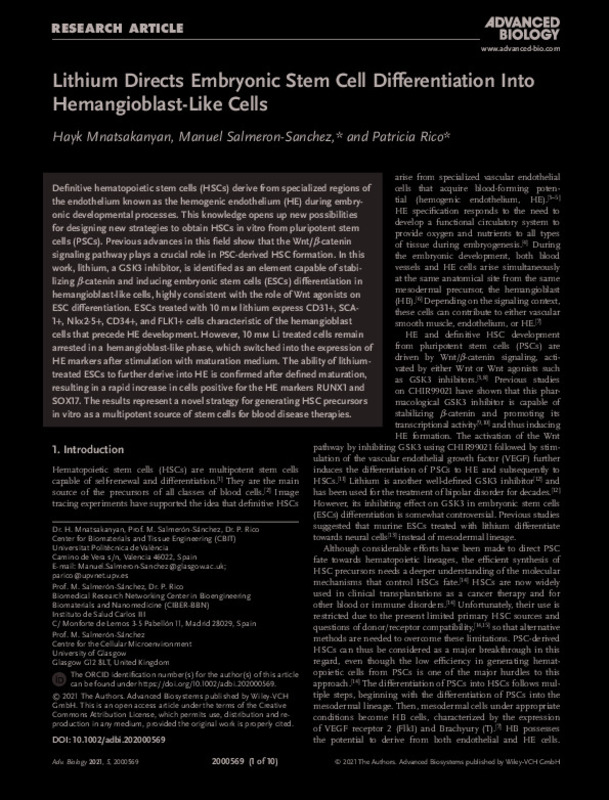JavaScript is disabled for your browser. Some features of this site may not work without it.
Buscar en RiuNet
Listar
Mi cuenta
Estadísticas
Ayuda RiuNet
Admin. UPV
Lithium Directs Embryonic Stem Cell Differentiation Into Hemangioblast-Like Cells
Mostrar el registro sencillo del ítem
Ficheros en el ítem
| dc.contributor.author | Mnatsakanyan, Hayk
|
es_ES |
| dc.contributor.author | Salmerón Sánchez, Manuel
|
es_ES |
| dc.contributor.author | Rico Tortosa, Patricia María
|
es_ES |
| dc.date.accessioned | 2022-07-12T18:05:02Z | |
| dc.date.available | 2022-07-12T18:05:02Z | |
| dc.date.issued | 2021-08 | es_ES |
| dc.identifier.uri | http://hdl.handle.net/10251/184045 | |
| dc.description.abstract | [EN] Definitive hematopoietic stem cells (HSCs) derive from specialized regions of the endothelium known as the hemogenic endothelium (HE) during embryonic developmental processes. This knowledge opens up new possibilities for designing new strategies to obtain HSCs in vitro from pluripotent stem cells (PSCs). Previous advances in this field show that the Wnt/beta-catenin signaling pathway plays a crucial role in PSC-derived HSC formation. In this work, lithium, a GSK3 inhibitor, is identified as an element capable of stabilizing beta-catenin and inducing embryonic stem cells (ESCs) differentiation in hemangioblast-like cells, highly consistent with the role of Wnt agonists on ESC differentiation. ESCs treated with 10 mm lithium express CD31+, SCA-1+, Nkx2-5+, CD34+, and FLK1+ cells characteristic of the hemangioblast cells that precede HE development. However, 10 mm Li treated cells remain arrested in a hemangioblast-like phase, which switched into the expression of HE markers after stimulation with maturation medium. The ability of lithium-treated ESCs to further derive into HE is confirmed after defined maturation, resulting in a rapid increase in cells positive for the HE markers RUNX1 and SOX17. The results represent a novel strategy for generating HSC precursors in vitro as a multipotent source of stem cells for blood disease therapies. | es_ES |
| dc.description.sponsorship | P.R. acknowledges support from the Spanish Ministry of Science, Innovation, and Universities (RTI2018-096794), and Fondo Europeo de Desarrollo Regional (FEDER). CIBER-BBN was an initiative funded by the VI National R&D&I Plan 2008-2011, Iniciativa Ingenio 2010, Consolider Program, CIBER Actions and financed by the Instituto de Salud Carlos III with assistance from the European Regional Development Fund. M.S.-S. acknowledges support from the UK Engineering and Physical Sciences Research Council (EPSRC - EP/P001114/1 | es_ES |
| dc.language | Inglés | es_ES |
| dc.publisher | John Wiley & Sons | es_ES |
| dc.relation.ispartof | Advanced Biosystems | es_ES |
| dc.rights | Reconocimiento (by) | es_ES |
| dc.subject | Differentiation | es_ES |
| dc.subject | Hematopoietic stem cell precursors | es_ES |
| dc.subject | Lithium | es_ES |
| dc.subject | Pluripotent stem cells | es_ES |
| dc.subject.classification | FISICA APLICADA | es_ES |
| dc.subject.classification | MAQUINAS Y MOTORES TERMICOS | es_ES |
| dc.title | Lithium Directs Embryonic Stem Cell Differentiation Into Hemangioblast-Like Cells | es_ES |
| dc.type | Artículo | es_ES |
| dc.identifier.doi | 10.1002/adbi.202000569 | es_ES |
| dc.relation.projectID | info:eu-repo/grantAgreement/AEI/Plan Estatal de Investigación Científica y Técnica y de Innovación 2017-2020/RTI2018-096794-B-I00/ES/DISEÑO DE MICROENTORNOS CELULARES PARA PROMOVER LA MECANOTRANSDUCCION SINERGICA DE CANALES DE IONES E INTEGRINAS/ | es_ES |
| dc.relation.projectID | info:eu-repo/grantAgreement/EPSRC//EP%2FP001114%2F1/ | es_ES |
| dc.rights.accessRights | Abierto | es_ES |
| dc.contributor.affiliation | Universitat Politècnica de València. Centro de Biomateriales e Ingeniería Tisular - Centre de Biomaterials i Enginyeria Tissular | es_ES |
| dc.contributor.affiliation | Universitat Politècnica de València. Departamento de Física Aplicada - Departament de Física Aplicada | es_ES |
| dc.contributor.affiliation | Universitat Politècnica de València. Departamento de Termodinámica Aplicada - Departament de Termodinàmica Aplicada | es_ES |
| dc.description.bibliographicCitation | Mnatsakanyan, H.; Salmerón Sánchez, M.; Rico Tortosa, PM. (2021). Lithium Directs Embryonic Stem Cell Differentiation Into Hemangioblast-Like Cells. Advanced Biosystems. 5(8):1-10. https://doi.org/10.1002/adbi.202000569 | es_ES |
| dc.description.accrualMethod | S | es_ES |
| dc.relation.publisherversion | https://doi.org/10.1002/adbi.202000569 | es_ES |
| dc.description.upvformatpinicio | 1 | es_ES |
| dc.description.upvformatpfin | 10 | es_ES |
| dc.type.version | info:eu-repo/semantics/publishedVersion | es_ES |
| dc.description.volume | 5 | es_ES |
| dc.description.issue | 8 | es_ES |
| dc.identifier.eissn | 2366-7478 | es_ES |
| dc.identifier.pmid | 33969645 | es_ES |
| dc.relation.pasarela | S\456579 | es_ES |
| dc.contributor.funder | European Regional Development Fund | es_ES |
| dc.contributor.funder | Ministerio de Ciencia, Innovación y Universidades | es_ES |
| dc.contributor.funder | Engineering and Physical Sciences Research Council, Reino Unido | es_ES |








